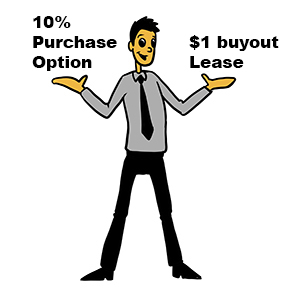 Moving along in our current lease discussion, let’s talk about the 10% purchase option lease.
Moving along in our current lease discussion, let’s talk about the 10% purchase option lease.
Essentially, the 10% purchase option lease is similar to the $1 buyout lease we discussed last time (this post will answer a common question I get: “what’s the difference between a $1 buyout lease and a 10% purchase option lease”, to which I always jokingly answer “about 9.9%”… I’m aware that answer really makes no mathematical sense, but it also gets a chuckle at the party.)
But truthfully, the difference is really just a simple matter of the payout at the end to own the equipment. As we learned last post, a $1 buyout lease is used when a company wants to lease an item, but also wants to eventually own it. This keeps the equipment off the company’s books as they pay for it, which makes the accountant happy.
So in a 10% purchase option lease, the same exact thing applies, except at the end of the term, the lessee has the option of a purchase that is 10% of the item’s original value (which was determined at the beginning of the lease.) This means the part of the price that lease payments are based on is smaller, making the monthly payment lower.
To illustrate this, let’s pretend an item worth $100 is being leased for ten months ($100 being a nice, easy number for our example, and 10 months is a nice easy number to divide into it).
- $1 buyout = $99 leased + $1 buyout at the end. Payments are based on $99 – this works out to $9.90 a month.
- 10% purchase option = $90 leased + $10 buyout at the end. Payments are based on $90 – this works out to $9 a month.
(Obviously, I’m leaving interest / fees off of these. No sense making it more complicated to show you the difference.)
But as you can see, in any equal term length, the monthly payment will be lower on the 10% purchase option lease. And that’s usually the reason a company would choose a 10% purchase option lease over a $1 buyout. You’re deferring more money to the end of the term, and keeping today’s payments smaller. This can really add up if you are leasing items worth thousands / hundreds of thousands.
The other reason is the 10% purchase is an option, and if the numbers / item / business direction don’t favor ownership, the company can walk away from the equipment without paying that last 10% (which again, could be a good sized number.)
Next, we’ll talk about Fair Market Value (FMV) leases.
